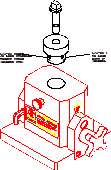|
Tool Cleaning and Lubrication should be part of any maintenance program. Regardless of what type of oiling system or grease you use, it is important to visually inspect the tooling from time to time. Certain materials, such as hot roll or galvanized steel, have a tendency to flake or scale. This foreign matter can work its way into the guide assembly and have a galling effect causing the tools is seize up inside the guide assembly or turret bore. Limit Tool and Turret Wear: Lubricate wear surfaces of punch, guide, and turret, applying a quality bearing grease such as “CLM L2-71 Extreme Pressure Grease” . Other choices are graphite or molly based grease, or a light coat of machine oil such as a 20-30 weight oil. Some tool systems like CE’s SL™ & competitors S80 holders incorporate 80-90 weight oil to seep from a built in reservoir. Further, tooling systems like C.E.’s LS™ & competitors 90abs, S90wls & Ultra units are designed for machines equipped with ABS (Air Blow Systems) or ATL (Auto Tool Lube). |
|
TOOL MAINTENANCE |


|
ToolEdge Life: There are many factors which determine the actual useable life of a punch & die between sharpenings such as rigidity of press, type of material (stainless, aluminum, mild steel, etc...) the turret itself, wear tolerances of holders and material thickness. |
|
Fully disassemble the tools wiping out all old oils or greases. Do not use: 1)Sulfur-based grease/acid-based lubricants, 2)Lightweight oils, 3)An air hose to clean turret or tool as particles of dirt can contaminate and possibly lodge slivers in die bases or turret bores. |
|
Tool Sharpening: The actual physical process of grinding(sharpening) can greatly effect the tools continued performance! Improper tool sharpening can cause premature tool edge failure. If you heat up the tool, you may be annealing the steel, bringing down its hardness, thus causing lower wear resistance. Further, if the steel discolors during a grinding pass or on a following pass, these burn marks can be hidden. The steels surface may later form surface cracks (buckling of the outer most skin surface). If facilities aren’t available to properly care for your tooling, CE offers a tool sharpening service. Sharpen tools when edge shows .01-.015 of break down. Punches often require sharpening 2-3 times more often than dies. If the tools are not sharpened at proper intervals, edge breakdown becomes more rapid & hole quality deteriorates. This will require much more metal removal to achieve a sharp edge and the result is much less tool life.. |
|
Grinding Wheel Selection: Use an open coarse wheel, a 60 grit, J hardness works well. Dressing of Grinding Wheel: Move diamond across wheel at a fast steady pass of (4 IPM). Take multiple passes at depths of .001-.002”. A good way to think of dressing is that your using the diamond to rip out the dull stone particles to expose fresh jagged edged stones. Grinding Tool: Take frequent light passes of no more than .0005 to .001 inch. Removal of more than this may cause the tool steel to burn, resulting in the edge becoming brittle, and chipping on the edges or corners. Keep Constant Flood Coolant on tool to prevent steel from heating up. Removal of .005 to .010” should return the tool to the proper sharpness. By hand, rub a medium oil/india stone on newly sharpened edges to reduce strengthen and reduce edge wear during punching. Lastly, Demagnetize tools to prevent punched slugs and slivers from adhering to them. |
|
Back to Technical Ref. Index |

|
CLM L2-71 Extreme Pressure Grease Catalog No. Description |
||
|
*A-CLM-4 |
One (4%) Jar |
|
|
*A-CLMG-16 |
One (16%) Tube |
|
|
*A-CLMG-64 |
One (64%) Tub |
|
|
Polishing Stone A hard structured stone perfect for removing galling from punch tip. Cat No.*A-GCS-32180K |